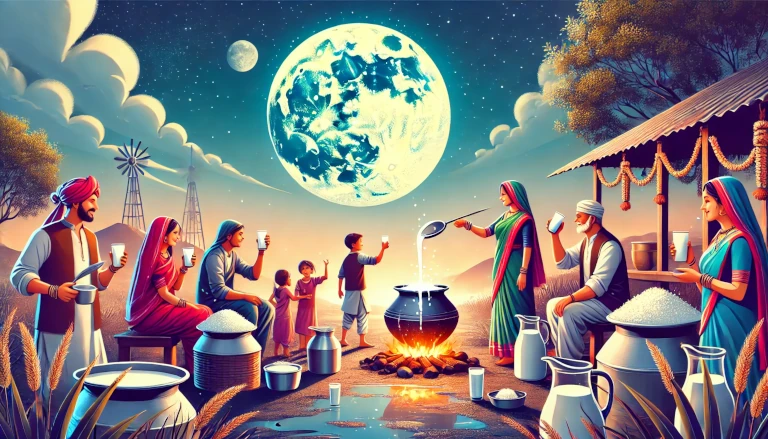Kojagiri Purnima, also known as Sharad Purnima, is a revered Hindu festival celebrated on the full moon night of the Ashwin month. Among the various rituals associated with Kojagiri Purnima, the tradition of drinking milk is particularly popular. On this night, people prepare Masala Doodh (spiced milk), leave it under the moonlight, and then share it with family and friends. This practice, which dates back to ancient times, is believed to carry spiritual, health, and cultural significance.
In this blog post, we will explore why people drink milk on Kojagiri Purnima, the symbolism behind this ritual, and how it reflects the festival’s deeper meaning. Understanding these customs can help you appreciate the rich traditions associated with Kojagiri Purnima.
The Significance of Drinking Milk on Kojagiri Purnima 🥛
The tradition of drinking milk during Kojagiri Purnima is linked to ancient beliefs and practices. Here’s why this custom is an essential part of the festival:
1. Symbol of Health and Wellness 🌿
In Hindu culture, milk is considered a pure and nourishing substance that promotes health and well-being. On Kojagiri Purnima, the moon is believed to emit special rays that infuse the milk with healing properties. Consuming this moonlit milk is thought to enhance immunity and provide various health benefits.
- Example: Families prepare Masala Doodh using milk, cardamom, saffron, and nuts, and allow it to sit under the moonlight to absorb its positive energy.
2. Offering to the Moon and Goddess Lakshmi 🪔
Kojagiri Purnima is dedicated to Goddess Lakshmi, the goddess of wealth, and is celebrated in reverence to the full moon. Milk is offered to the moon as a symbol of gratitude and to seek blessings for prosperity and abundance.
- Tip: After offering the milk to the moon, it is consumed as prasad, believed to carry divine blessings.
3. Connection to the Moon’s Healing Powers 🌕
Ancient Indian scriptures mention the moon’s influence on mind and body. On Kojagiri Purnima, the moon is said to be at its most potent, capable of enhancing the nutritional value of milk. Many believe that drinking milk on this night can calm the mind and improve mental clarity.
- Example: People enjoy a quiet evening under the full moon, drinking Masala Doodh, and experiencing the calming effects of the moonlight.
The Ritual of Preparing and Drinking Masala Doodh 🥛🌙
Masala Doodh, or spiced milk, is a popular drink prepared on Kojagiri Purnima. This drink is enriched with spices and nuts, symbolizing purity and abundance. Here’s how this ritual is typically observed:
1. Preparing the Masala Doodh 🍶
Ingredients like milk, cardamom, saffron, almonds, pistachios, and sugar are used to make this special drink. The milk is boiled with these spices, creating a fragrant and flavorful beverage.
2. Exposing the Milk to Moonlight 🌌
The prepared Masala Doodh is placed in a silver or stainless-steel vessel and left outdoors under the moonlight. It is believed that this exposure infuses the milk with the moon’s beneficial properties.
- Tip: Placing the milk in moonlight for at least an hour is thought to enhance its spiritual and healing qualities.
3. Sharing the Moonlit Milk with Family and Friends 👨👩👧👦
After allowing the milk to absorb the moon’s rays, it is shared with family and friends. This communal act fosters togetherness and reflects the festival’s spirit of unity and gratitude.
Why Masala Doodh? 🌼
Masala Doodh is not just any milk. The addition of spices like cardamom, saffron, and nuts adds to its symbolic and healthful properties:
- Cardamom 🌱: Known for its digestive benefits and soothing aroma, cardamom symbolizes warmth and hospitality.
- Saffron 🌼: A luxurious spice, saffron is associated with purity and abundance. It also has antioxidant properties that benefit health.
- Nuts 🌰: Almonds, pistachios, and other nuts are added to enrich the drink, symbolizing prosperity and well-being.
The Cultural Significance of Milk in Hindu Traditions 🐄
Milk has a profound spiritual and cultural significance in Hinduism, symbolizing purity, nourishment, and divine love. Here’s why milk is often chosen as an offering in Hindu rituals:
1. Represents Purity and Devotion 🌸
In many Hindu ceremonies, milk is used as an offering to deities because of its association with purity and sanctity. Drinking milk on Kojagiri Purnima symbolizes receiving divine blessings and nurturing the soul.
2. Connection to Mother Nature 🌍
Milk is derived from cows, which are highly revered in Hindu culture. This connection to nature reinforces the values of respect for animals and gratitude for nature’s gifts.
3. Promotes Community and Sharing 👨👩👧👦
Sharing milk on Kojagiri Purnima brings people together, fostering a sense of community and mutual respect. It’s a simple yet powerful reminder of the importance of kindness and generosity.
How to Celebrate Kojagiri Purnima with Masala Doodh at Home 🏠
To partake in this cherished tradition, here’s a simple way to prepare and enjoy Masala Doodh at home:
- Gather the Ingredients 🍶: You’ll need milk, sugar, cardamom, saffron, almonds, and pistachios.
- Boil the Milk with Spices 🌸: Add the spices and nuts to the milk and let it simmer until aromatic.
- Expose to Moonlight 🌕: Place the milk in a bowl or container and leave it outdoors under the full moon for an hour or more.
- Share with Loved Ones 👨👩👧: Gather family and friends to enjoy the Masala Doodh together, sharing blessings and good wishes.
Embracing the Tradition of Kojagiri Purnima with Milk 🌕
The custom of drinking milk on Kojagiri Purnima is a beautiful tradition that combines spirituality, health, and community. Whether you’re drawn to the ancient beliefs about moonlit milk or the simple joy of sharing a warm drink with loved ones, Kojagiri Purnima offers an opportunity to connect with nature and celebrate the blessings of Goddess Lakshmi. By observing this tradition, we honor the past and create cherished memories for the future.
Discover more from Green Ecosystem - Renewable Energy, Agriculture, and Environmental Sustainability
Subscribe to get the latest posts sent to your email.


